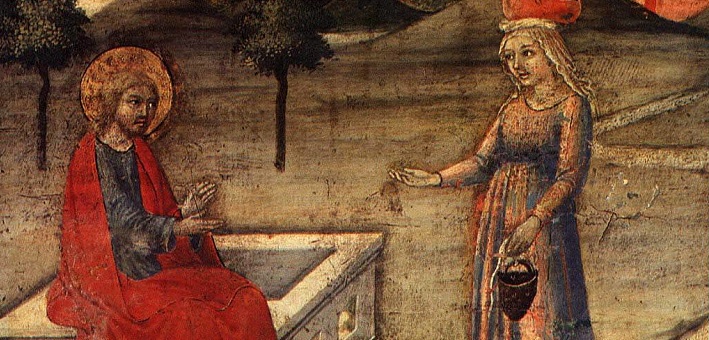Commentary on John 4:1-42
Recently I taught a series on the Gospel of John in a church, as I often do. Having finished reading about Nicodemus, the named Jewish male who came to Jesus by night, we turned to the unnamed Samaritan woman. I asked, “What do you notice about this woman?” and the first person responded, “She comes to Jesus at noon, when none of the other women would be around to give her grief about her sordid past.” The first clause is true; the rest of the sentence is not supported by the text but is the most common response I hear.
This is a story of a woman presented as a paradigmatic disciple who encounters the Light of the World at the brightest time of day, noon. We the readers are supposed to do exactly as she does. What does that entail? Engage in continued, vital theological conversation with Jesus, gain a deeper, layered understanding of who he is and the life he brings, then testify to others and invite them to have their own primary encounter with Jesus.
Typical interpretations of this passage trouble me in two separate ways. First, they make erroneous statements about what is in the text. Second, they fail to present the incredibly rich features that are in the text. Thus, your task as the preacher is always two-fold with this story. First, you have to “clear the decks;” that is, make sure listeners understand what the text is not about, given the assumptions they will bring with them if they’ve heard this text before. Second, you will invite them into the layers of meaning here (without overwhelming them since many, many sermons can be preached from this text from different angles).
Clearing the Decks: What this Text is not about
The text does not say the woman is a prostitute; it says she had husbands, not customers. We have no idea if the husbands died, if she was divorced, if Levirate marriage was involved. The text does not say. It also does not say that Jesus forgave (aphiemi) the woman of anything. If this were just a story of Jesus forgiving a prostitute, we would see the language of sin, forgiveness, or “prostitute,” on the one hand, and this story would be a lot shorter on the other hand!
But the story is quite long and involved. The main point involves Jesus and this woman having a deep, rich theological debate that allows them to form an intimate connection across real and perceived differences such that the woman receives the first theophany (manifestation of God) in the Gospel of John and then evangelizes her community.
The Bridegroom at the Well: Illumination, Fulfillment, and Water for Thirsty Souls
The story opens with Jesus heading back to Galilee from Jerusalem. He chooses to go through Samaria. Literally speaking, he did not “have to” go through Samaria (verse 4); in fact, given the rancor between Jews and Samaritans, it would have been more typical for him to take a different route. He “has to” because in this Cana to Cana cycle that starts with the wedding in Cana and ends with the healing of the official’s son in Cana (4:46-54), we see Jesus’ scope making him “the Savior of the world.”
The scene takes place at Jacob’s well. Jacob is a common ancestor for the woman and Jesus, and wells are sites of betrothal in the Old Testament. It is where their shared father Jacob met Rachel for the first time in Genesis 29:10 (see also Moses and Zipporah and Isaac and Rebekah’s stories).
In John Jesus is a bridegroom, as John the Baptist (the friend of the bridegroom) indicates:
“He who has the bride is the bridegroom. The friend of the bridegroom, who stands and hears him, rejoices greatly at the bridegroom’s voice” (John 3:29).
God’s people are often depicted as a bride in both the Old Testament and New Testament (Isaiah 62:5; Jeremiah 2:2; Hosea 2:16-20; Revelation 19:6-8; 21:9-10). Here we have the true bridegroom, Jesus, who is also God in John, meeting a woman of Samaria. It is important to recall two points:
- Jews considered Samaritans to participate in idolatrous worship (read 2 Kings 17:13-34) since they worship foreign gods in addition to God.
- Prophets in both the Old and New Testaments depict false worship in sexualized terms using marital imagery (which has had some unfortunate gender consequences). She calls him a prophet not because he reads her palm or makes Nostradamus-like predictions, but because prophets take issue with what they consider to be idolatry.
Without this background knowledge, the conversation does not make much sense. With it, one can see what Sandra Schnieders calls “the wooing of Samaria” on the part of Jesus, the true bridegroom. That both Jesus and the Samaritan woman represent people groups is shown not only by the talk of what “our ancestors” did, but also in the change from the singular, “Woman” to the plural in verse 21: “You (plural) worship what you (plural) do not know; we worship what we know, for salvation is from the Jews” (John 4:22). As Schneiders notes, the five husbands are the five foreign Gods; the sixth represents the incomplete worship of the God of Israel. This makes Jesus number seven, the number of fullness and completion. The woman continues to express her tradition about the Messiah to come. At that moment, Jesus reveals himself as not only greater than Jacob, and not only the expected Messiah, but God: “I am” (ego eimi) he says, invoking God’s own name for Godself from Exodus when interacting with Moses (Exodus 3:14).
With this moment of perfect fulfillment, the woman leaves her water jar. She came at the brightest part of the day seeking water; she encounters the Light of the World, the true Light which enlightens all people (even Samaritans) and now has Living Water to spare (hence, no need for the jar).
Sharing from the Overflow
The Gospel of John calls the reader to encounter Jesus, believe in him, testify to the ways he brings abundant life to everyone, and invite others to “come and see” for themselves. This is exactly what the Samaritan woman does. The more she engages Jesus from her theologically educated and committed faith, the deeper her understanding of him becomes. He starts out as just a Jewish man (4:9) asking her for something. Then she understands him to be a prophet and Messiah. God has revealed Godself to her. Out of that abundant spring of water that overflows in her soul, she immediately testifies to her neighbors and many (polloi) believe on account of (dia) the word (logos) of the woman’s testimony (martureo) (John 4:39 NRSV). Just like John the Baptist, who declared “he must increase, but I must decrease” (3:30), she directs her audience to Jesus that they, too, might come to believe, testify, and embrace the abundant life he brings (John 10:10).
Notes
For Further Reading:
Clark-Soles, Jaime. Reading John for Dear Life: A Spiritual Walk with the Fourth Gospel. Louisville: Westminster John Knox, 2016.
McGrath, James. What Jesus Learned From Women. Cascade, 2021. An unusual, imaginative take.
Schneiders, Sandra: Written That You May Believe: Encountering Jesus in the Fourth Gospel. Herder & Herder, 2003.
PRAYER OF THE DAY
God of life,
Shower us in your living water, bringing us to new life, fresh and clean. Walk with us as we share the knowledge of your living water with others, so that all might live. Amen.
HYMNS
For all the faithful women ELW 419
Take my life, that I may be ELW 583, 685, H82 707, UMH 399, NCH 448
O sons and daughters ELW 386
CHORAL
Give me Jesus, Larry Fleming


January 30, 2022